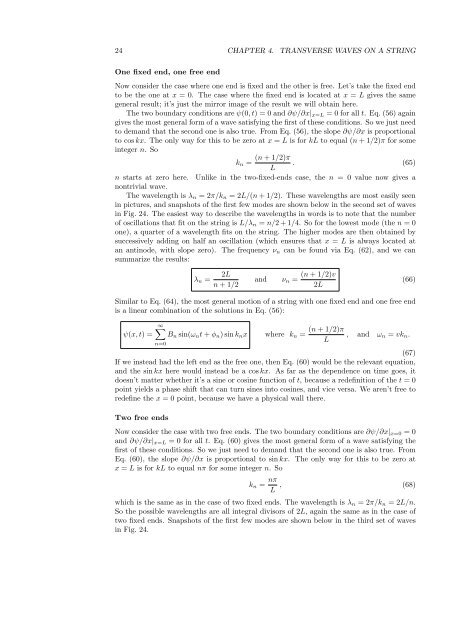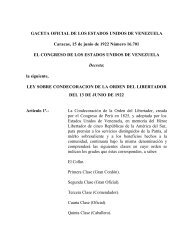Transverse waves on a string - People.fas.harvard.edu
Transverse waves on a string - People.fas.harvard.edu
Transverse waves on a string - People.fas.harvard.edu
Create successful ePaper yourself
Turn your PDF publications into a flip-book with our unique Google optimized e-Paper software.
24 CHAPTER 4. TRANSVERSE WAVES ON A STRING<br />
One fixed end, <strong>on</strong>e free end<br />
Now c<strong>on</strong>sider the case where <strong>on</strong>e end is fixed and the other is free. Let’s take the fixed end<br />
to be the <strong>on</strong>e at x = 0. The case where the fixed end is located at x = L gives the same<br />
general result; it’s just the mirror image of the result we will obtain here.<br />
The two boundary c<strong>on</strong>diti<strong>on</strong>s are ψ(0, t) = 0 and ∂ψ/∂x|x=L = 0 for all t. Eq. (56) again<br />
gives the most general form of a wave satisfying the first of these c<strong>on</strong>diti<strong>on</strong>s. So we just need<br />
to demand that the sec<strong>on</strong>d <strong>on</strong>e is also true. From Eq. (56), the slope ∂ψ/∂x is proporti<strong>on</strong>al<br />
to cos kx. The <strong>on</strong>ly way for this to be zero at x = L is for kL to equal (n + 1/2)π for some<br />
integer n. So<br />
(n + 1/2)π<br />
kn = . (65)<br />
L<br />
n starts at zero here. Unlike in the two-fixed-ends case, the n = 0 value now gives a<br />
n<strong>on</strong>trivial wave.<br />
The wavelength is λn = 2π/kn = 2L/(n + 1/2). These wavelengths are most easily seen<br />
in pictures, and snapshots of the first few modes are shown below in the sec<strong>on</strong>d set of <str<strong>on</strong>g>waves</str<strong>on</strong>g><br />
in Fig. 24. The easiest way to describe the wavelengths in words is to note that the number<br />
of oscillati<strong>on</strong>s that fit <strong>on</strong> the <strong>string</strong> is L/λn = n/2 + 1/4. So for the lowest mode (the n = 0<br />
<strong>on</strong>e), a quarter of a wavelength fits <strong>on</strong> the <strong>string</strong>. The higher modes are then obtained by<br />
successively adding <strong>on</strong> half an oscillati<strong>on</strong> (which ensures that x = L is always located at<br />
an antinode, with slope zero). The frequency νn can be found via Eq. (62), and we can<br />
summarize the results:<br />
λn = 2L<br />
n + 1/2<br />
and νn =<br />
(n + 1/2)v<br />
2L<br />
Similar to Eq. (64), the most general moti<strong>on</strong> of a <strong>string</strong> with <strong>on</strong>e fixed end and <strong>on</strong>e free end<br />
is a linear combinati<strong>on</strong> of the soluti<strong>on</strong>s in Eq. (56):<br />
ψ(x, t) =<br />
∞<br />
Bn sin(ωnt + φn) sin knx where kn =<br />
n=0<br />
(n + 1/2)π<br />
L<br />
(66)<br />
, and ωn = vkn.<br />
(67)<br />
If we instead had the left end as the free <strong>on</strong>e, then Eq. (60) would be the relevant equati<strong>on</strong>,<br />
and the sin kx here would instead be a cos kx. As far as the dependence <strong>on</strong> time goes, it<br />
doesn’t matter whether it’s a sine or cosine functi<strong>on</strong> of t, because a redefiniti<strong>on</strong> of the t = 0<br />
point yields a phase shift that can turn sines into cosines, and vice versa. We aren’t free to<br />
redefine the x = 0 point, because we have a physical wall there.<br />
Two free ends<br />
Now c<strong>on</strong>sider the case with two free ends. The two boundary c<strong>on</strong>diti<strong>on</strong>s are ∂ψ/∂x|x=0 = 0<br />
and ∂ψ/∂x|x=L = 0 for all t. Eq. (60) gives the most general form of a wave satisfying the<br />
first of these c<strong>on</strong>diti<strong>on</strong>s. So we just need to demand that the sec<strong>on</strong>d <strong>on</strong>e is also true. From<br />
Eq. (60), the slope ∂ψ/∂x is proporti<strong>on</strong>al to sin kx. The <strong>on</strong>ly way for this to be zero at<br />
x = L is for kL to equal nπ for some integer n. So<br />
kn = nπ<br />
L<br />
, (68)<br />
which is the same as in the case of two fixed ends. The wavelength is λn = 2π/kn = 2L/n.<br />
So the possible wavelengths are all integral divisors of 2L, again the same as in the case of<br />
two fixed ends. Snapshots of the first few modes are shown below in the third set of <str<strong>on</strong>g>waves</str<strong>on</strong>g><br />
in Fig. 24.

















